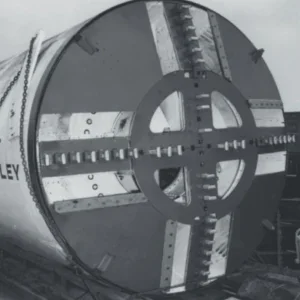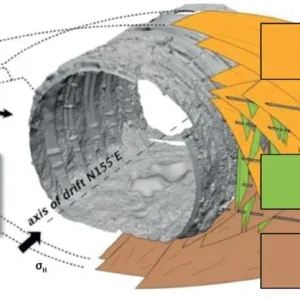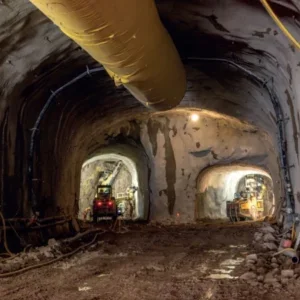The work of consulting engineer Rocksoil is held in very high esteem in Italy. The result for the company, based in Milan, and still presided over by founder Prof Pietro Lunardi, has been the placing of large contracts for railway, motorway and other tunnel work with them by a variety of government departments and private clients. Their approach to the solution of rock mechanics/tunnel design is intriguing.
To avoid collapse when creating an underground space, it is necessary to harness the natural arching capability of the rock. The arching may take place close to the tunnel, or further from the perimeter when it may be necessary to enhance this natural action by temporary support. When arching does not occur naturally, for example in weak and/or weathered rock or in difficult stress fields, it must be created artificially. This is done by treating the ground before it is excavated.
To arrive at the correct solution, a good understanding of the rock strength and quality are needed, together with details of the stress conditions in the location and at the appropriate depth. Deformation is expected under most conditions, diminishing with time. This includes ‘extrusion’ of the face, a convex deformation of the unsupported tunnel face.
Essence of ADECO
The essential precepts of the ADECO methods evolved by Rocksoil are:
– Separate design and construction
– Predict deformation
– Classify rock conditions
– Analyse observed deformations
– Advance by full-face
– Stiffen the core of the face in advance, if required
– Close the invert quickly and very near to the face
– Use simple technology for construction and control of the works.
At the design stage the proposed tunnel is classified into A, B or C, (see diagram), with good site investigation data adding to the quality of the analysis.
Type A represents a completely stable face. Type B face is stable in the short term and Type C is unstable. These types are sub-divided depending on the combination of conditions present. At design stage, therefore, the tunnel is classified into A, B or C and the lining and construction method defined. One interesting feature of the ADECO philosophy is the reinforcement of the face to control its movement and stability. This enables the full-face advances to be accomplished. The subdivisions of the A, B and C categories show the different methods usually adopted for stiffening the core.
When construction begins a significant amount of instrumentation is placed ahead of the face as well as in the tunnel. The preconvergence, or movements in the ground ahead of the excavation, are monitored as well as the convergence in the tunnel. This extrusion movement in front of the excavated face is a good indicator of the tunnel type.
The behaviour of the ground is compared with the predictions. In fact the core is used as support for the face by stiffening it in advance of the excavation. This can be done in a variety of ways depending on the rock properties. Glass-fibre pipes are a favourite, as they are easy to excavate as the tunnel progresses. Other methods include grout injections, pre-draining, and nailing with glass-fibre tubes. By way of an example, a Type C tunnel could have core reinforcing carried out up to 24m in advance of the face. 1 to 1.5m advances would be made up to a maximum of 12-14m before the invert was closed, completing the arch. Sliding micrometers are used to measure the extrusion of the tunnel face and the extent of movement in the core. The observations made are fed back into the design to refine the construction process in the engineering sense, and in the economic sense. The amount of equipment is increased or decreased, as necessary, in response to the design review.
Case histories
Cassani continued with a number of case histories, each illustrating the application of the ADECO philosophy in differing circumstances. Two of the most interesting are described briefly.
Rocksoil is the designer and on-site supervisor for the new Bologna-Florence high-speed railway line, much of which lies in tunnels. Typically the tunnel has a 141m2 cross-section and adits of 60m2 in section, but for the last 14km at the Florence end, the adit is a service tunnel of 114m2 cross-section, and has been constructed by TBM. The route of the new line crosses the Appenines and has encountered almost every sort of tunnel condition. In essence it has broken down into 30% Type A, 50% Type B and 20% Type C. Substantial site investigation preceded the design stage where the choice of cross-section was made. In fact 14 different cross-sections were used in the design. The advance length and advance rate were also set. These came more from experience than mathematics.
In 78 months, 90km of tunnel has been constructed. There is still about a year to go until the tunnels are complete. The typical tunnel advance has varied from 1.5 to 7m/day. The best advance was 1,880m in one month, but the overall average advance has been around 1.5m/day.
The second project discussed was an underground station near the Vatican in Rome. With four and five storey buildings very close to the works settlement was a big issue. With a 24m span and only 20m overburden in slightly overconsolidated clay, construction techniques were critical for controlling ground movements and stability.
An 8m high, 7m wide pilot tunnel was driven on either side of the main excavation, the core reinforced with glass fibre bolts. The crown of the tunnel was excavated under a canopy of shotcrete applied in a pre-cut slot. This also formed the upper part of the walls. A precast segmental lining was then placed on the side walls. A face of up to 300m2 in cross sectional area was open at some stages of the work.
Various other TGV projects in France were used as illustrations for the ADECO approach to tunnel design and construction.
In all, this was a very thorough explanation of the methods evolved by Prof Lunardi and practised by his company. The wide ranging examples showed the breadth and volume of work undertaken by the company in Europe. Above all Dott Ing Cassani’s personal contribution to the work presented was evident and her position as director of design standards for Rocksoil is to be envied.
Related Files
Definition of behaviour categories
Choice of stabilisation methods







